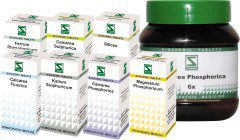Doctors Zone
Journal (JEBH)
Alpha™- Liv Drops
Alpha – Liv Drops Due to high demand from the market, for a formulation in drops for the liver, apart from the syrup already available in the market, Schwabe India developed this product. Introduction The liver plays a key role in metabolism. It has anabolic and catabolic, exocrine and endocrine functions. The liver is a blood reservoir, filter and store of different substances (e.g. glycogen, vitamins). It is the site of serum protein (e.g. albumin, prothrombin, fibrinogen) and enzyme synthesis. Metabolic processes (e.g. bilirubin, hormone, carbohydrate and lipid turnover) and the removal of toxic products are important liver functions. 1 Hepatotoxins (e.g. alcohol, tetracycline, acetaminophen, fungal toxins, and anabolic steroids) can cause specific damage to liver cells. Toxic hepatitis may be clinically silent or severe enough to lead to the rapid development of hepatic failure. Clinical features include hepatomegaly, enzyme abnormalities, fever, abdominal pain, anorexia, nausea, vomiting and weight loss. In patients with underlying cirrhosis, manifestations of portal hypertension may predominate. Aversion to fatty food, abdominal discomfort, nausea and vomiting after meals may be symptoms of 2 cholelithiasis. Jaundice results from accumulation of bilirubin. It has non-hepatic as well as hepatic causes. Hyperbilirubinaemia may be due to abnormalities in the 3 formation, transport, metabolism or excretion of bilirubin. TM Alpha -Liv Drops aids recovery and normalisation of liver functions. Severe liver disease needs specialised treatment. Indications: Slow liver functions, fatty liver, and for supportive treatment of hepatocellular jaundice and toxic liver damage.

Schwabe News 2016 June- Mother tincture info – Hepatica triloba
Hepatica triloba
Its common name is liverwort and botanical name is Hepatica nobalis. The genus name Hepatica refers to the liver like shape of the leaves. It is an evergreen, stemless herb, with a fibrous root. It grows up to 5-15 cm in height. The leaves are round have three lobes and hairless when old and fleshy, dark olive green and purplish beneath when old. The flowers are purplish, blue, or nearly white during winter and spring. Flowers are solitary and have 5-10 oval showy sepals and 3 green bracts1.
It is native to Cooler latitudes of the North Temperate Zone, Great Britain, Europe, northern Asia, North America, and northern Mexico, etc.
Hepatica contains only the ordinary constituents of herbs. It contains tannin, sugar, mucilage, protoanemonin; its value is due to its astringent principle.
It is covered by Homoeopathic Pharmacopoeia of India as well as Homoeopathic Pharmacopoeia of United States.
It is indicated in Pharyngeal catarrh, with profuse, serous sputa and hoarseness, tickling and irritation of the throat. It also used in scraping and rough sensation in throat, causes free and easy expectoration. Viscid, thick, tenacious phlegm causes continued hawking. Patient may complaint pain in the nostrils2. It has sensation about epiglottis as if particles of food remained. It is used in Sputa sweet, profuse, creamy with hepatic congestion.3 It is reported that some herbalists include it in treatments for pimples, bronchitis and gout.4
Recommended dose: 5-20 drops 2-3 times a day.
References:
- P. N. Varma, Indu Vaid, Encyclopaedia of Homoeopathic Pharmacopoeia, Updated edition 2007, B. Jain Publishers, New Delhi.
- W. Boericke, New Manual of Homoeopathic Materia Medica & Repertory [with Relationship of Remedies], Second Re-Augmented & Revised Edition Based on Ninth Edition, Reprint Edition 2002, B. Jain Publishers, New Delhi.
- A. L. Blackwood, A Manual of Materia Medica, Therapeutics and Pharmacology, Reprint Edition 1995, B. Jain Publishers, New Delhi.
- Howard, Michael. Traditional Folk Remedies (Century, 1987); p.161–2. Source: https://en.wikipedia.org/wiki/Anemone_hepatica#Contents
Recent Advancements in Basic Homeopathic Research – A Reporton Two Significant Publications
Author: Snigdha Suman Dalua , Praveen Kumar Singh In a study conducted at the Experimental Farm of the State University of Santa Catarina, Brazil, researchers investigated the impact of homeopathic treatments on piglets during the nursery phase. The study aimed to determine whether homeopathic agents could reduce fighting behavior, improve growth performance, and affect hematological, metabolic, and oxidative variables.
Journal of Evidence Based Homeopathy Volume: 1, Issue: 1, January - June 2023
Comprehensive articles

Agrohomeopathy – A Review
Short cases

Unmasking the Intricacies: A Pyogenic Abscess Case Report

Lichen Simplex: A Singular Case Study

Ranula Unveiled: A Case Report and Management Approach

Lichen Simplex: A Singular Case Study

A Puzzling Presentation: A Case Report of Jaundice
Recent provings and updated materia medica

Acidum Formicum

Mygale

Thea Chinensis
Materia medica on phytohomeopathy

Chrysarobinum

Sanguinarinum nitricum

Thiosinaminum
Mother tincture

Asparagus Officinalis

Ginkgo Biloba

Rosmarinus Officinalis
Product watch

Alpha™- Liv Drops

Good Morning™ Constipation Drops

Zauber™ Hair Drops
Research News
























